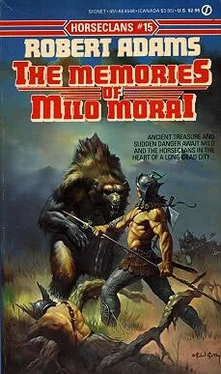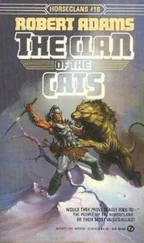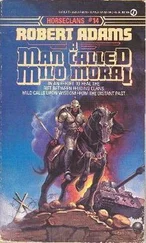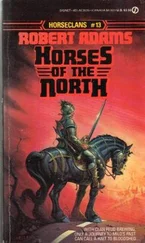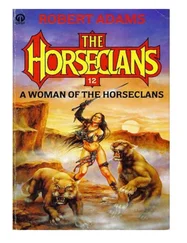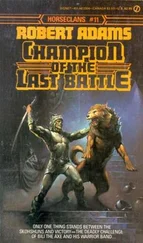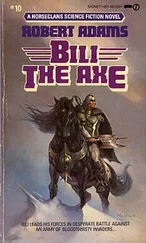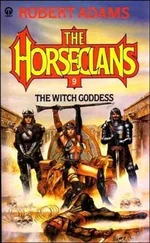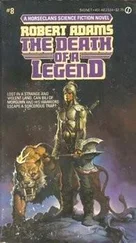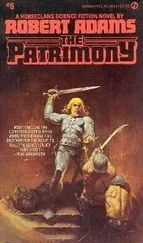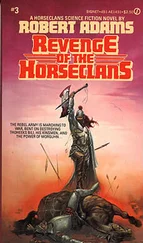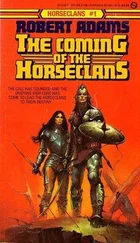Behind the arc of hunters, but always within sight of them, rode the blooded warriors of both clans. These men all rode in full armor—most of this being of hardened leather; metal was so scarce and so hideously expensive that it was saved for the fashioning of weapons and tools only, and among the poorer clans even the heads of arrows were often of knapped stone, fire-hardened bone or sharpened horn to conserve metal supplies—their short, recurved, horsemen’s bows ail strung but cased, weapons and targes slung within quick, easy reach, minds open to receive any communication from the cats or the hunters ahead of them, the flankers to either side or the rearguard who trailed a half-mile behind the tail of the column.
At variable distances behind the warriors came the wagons and carts, wagons drawn by three or four span of brawny oxen, carts by oxen or mules or horses, many of them trailing on tethers milk cows and nanny goats. The herd of sheep and goats were driven on the flanks and fairly close to the carts and wagons, sometimes even among the fringes of them. But the cattle were kept back as much as possible, at least a half-mile back, usually. Where the drovers of the smaller herd animals went mostly afoot, those driving the cattle were all mounted not on hunting horses or warhorses, but on quick-footed, fast, and highly intelligent horses long accustomed to dealing with the big, dangerous, stupid and ever-unpredictable cattle; over the years, more Horseclansmen and Horseclanswomen, boys, girls, horses, dogs and slaves had been killed or injured by cattle than by any other single cause—war, accident, hunting, anything.
Dangerous or not, however, the herds were very necessary to the nomadic clans, for no meaningful number of folk could live well or for long through hunting and wild-plant gathering alone. Cattle and sheep and goats were necessary for more than simply their milk and meat. The vast majority of the leather goods of the Horseclans was made of cowhide, the hair of the cattle made felt, horn became many utensils and armor and backing for hornbows, sinew had hundreds of uses, hooves were rendered into jelly and glue, internal organs became liners for skin water carriers and pouches to carry items such as tobacco and other herbs that must be constantly kept from dampness, bones became tools and weapons, fat was rendered into tallow for the lighting of yurts. And because the possession of them was so necessary, the wealth of a clan had come to be reckoned by the number of cattle in its herds. Sheep and goats were important in their own rights to the continued survival and well-being of their owners, but they still were not afforded the same degrees of importance as were the vile-tempered, stubborn, powerful and incipiently deadly cattle, not among the free-roaming clans of nomads of the south, did they chance to be Kindred or no.
Clans Staiklee and Gahdfree had camped and trekked together for long years, and generations of intermarriage had rendered the two practically a single clan, a clan with two chiefs. Big Djahn Staiklee and Djim-Booee Gahdfree complemented each other, Staiklee being a superlative war chief and Gahdfree being equally good at planning the pursuits of peace, diplomatic dealings with those too strong or of too close a degree of Kindred to fight overtly or raid covertly and at bargaining with plains traders.
Staiklee and his father before him had the well-earned reputation of being extremely warlike; within two bare generations they and their clansmen had managed to wipe out or drive off most of the non-Kindred nomads and settlements of Dirtmen from end to end of their accustomed range, leaving only Clans Gahdfree, Ohlsuhn, Morguhn, Reevehrah and a very few other Kindred clans anywhere near. And even these Kindred tried to not stray too close to the stamping grounds of Big Djahn Staiklee for the good and sufficient reason that his nature was incurably acquisitive when it came to cattle and that a good portion of his herd consisted of “previously owned” beasts. The free-roving Horseclans did not engage in the practices of ear-notching or branding their cattle, so theft was a difficult charge to ever prove, and the various chiefs all felt it to be more circumspect to stay out of easy cattle-lifting distance of the otherwise quite amiable Chief Djahn of Staiklee than to risk a bloodfeud over a few steers and heifers and a bull or two.
But despite, and really because of, its wealth in cattle, Clan Staiklee (and, consequently, Clan Gahdfree, as well) was poor in metal. All of the ruins within the range had been long since combed over for metals, and Chief Djahn was most loath to sell or trade cattle for iron. His sire, Sam Hoostuhn Staiklee, had been of equal mind, and therefore most of the metal they did own had been taken in raiding or warring.
Of more recent years, Chief Djahn’s most frequent sparring partners had been the minions of Jorge, El Rey del Norte, northernmost of the five kings of Mexico. Chief Djahn had never met the man, of course, but he figured him to be a leader much like himself, considering the instant response that occurred whenever the Staiklees and Gahdfrees rode down into his kingdom after cattle, horses, women and loot.
Not that King Jorge’s warriors were all that good at warring; of course, few other clans’ and peoples’ warriors were anywhere nearly as good as those of Clan Staiklee, to Chief Djahn’s way of thinking. But the black-eyedsoldados of King Jorge, though usually well armed and mounted, and frequently possessed of a marked degree of individual courage, were mostly poorly led and invariably did the same things over and over through defeat after bloody defeat, at the capable hands of Chief Djahn and his crafty nomad warriors.
In his way, he was honest, and so Chief Djahn admitted to himself that this sudden move to the northeast was unquestionably a good one; for, of late, King Jorge’s soldados had come north in increasing numbers, often not even prompted by a Staiklee-Gahdfree raid. The numbers of soldados available to King Jorge seemed to be infinite, and although the clansmen always managed to finally defeat or outmaneuver their southern opponents, their numbers were relatively small at the outset and their losses in dead and maimed were adding up faster than young men were coming of an age to replace them.
So it was not simply avarice for wealth and metal-hunger that impelled Chief Djahn and his followers at so fast a pace along the route to the ancient, unlooted town, although he never would have openly admitted it to any other living person, even Chief Djim-Booee Gahdfree.
Far and far to the south, Don Jorge, El Rey del Norte, breathed a long sigh of relief and a prayer of thanksgiving when a parched and dusty squadron returned intact to inform him that the barbarians who had for so long menaced the more northerly reaches of his lands had at last departed with their herds and wagons and all else that they owned, headed in a direction that they never before had taken and apparently pausing only for night camps in their trek.
Obviously, the costly war of attrition conceived by the royal personage had succeeded. Now the ranchers and farmers could perhaps move safely northward onto the prairies.
By the time it became necessary to begin raising the water from the shrinking creek in buckets, old Mosix’s once-butter-soft hands were become hard and calloused enough to be equal to the tasks required. The old man now lived alone in his home; it was simply too far a walk for the younger sometime-priests to commute between there and the farms upon which they now labored for their sustenance, and so they all dined with the families of their employers and slept in lofts and attics and sheds and stables, leaving Mosix to do for himself, rattling around in the large house adjoining the old Council Chamber and the former library.
Читать дальше
